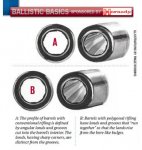Im curious having heard that Black Hole Weaponry (Columbia River Arms) is making bolt gun barrels. Does anyone have any experience with this type or rifling, or their barrels in a bolt gun chambered for a competition cartridge?
Some background: Octagonal rifling has been around for a long time, it is popular in pistols, Glocks are known for it also in AR's. Black Hole Weaponry is synonymous with an excellent quality AR barrel that will last. There are many "facts" or "myths" I have heard about these barrels and have never seen a quantifiable data to support them one way or the other.
Here are some of the fact/myths:
Polygonal barrels are hammer forged around a rifling "die" this induces greater stresses into the barrel that make it more prone to weakness. OR, this process, hammer forging, allows the grain structure to line up making it a stronger barrel.
Polygonal barrels are faster (I've heard claims of 50 FPS) because of a tighter seal around the bullet itself.
Polygonal barrels wear less due to less surface area of the bullet contacting the rifling.
Polygonal barrel cannot shoot lead bullets due to being more susceptible to leading.
Polygonal barrels need cleaned less, less copper is laid down buy the bullet.
So where is the truth, its hard to find definitive facts.
Does anyone here have any real first hand experience or data to support or refute any of these claims?
Some background: Octagonal rifling has been around for a long time, it is popular in pistols, Glocks are known for it also in AR's. Black Hole Weaponry is synonymous with an excellent quality AR barrel that will last. There are many "facts" or "myths" I have heard about these barrels and have never seen a quantifiable data to support them one way or the other.
Here are some of the fact/myths:
Polygonal barrels are hammer forged around a rifling "die" this induces greater stresses into the barrel that make it more prone to weakness. OR, this process, hammer forging, allows the grain structure to line up making it a stronger barrel.
Polygonal barrels are faster (I've heard claims of 50 FPS) because of a tighter seal around the bullet itself.
Polygonal barrels wear less due to less surface area of the bullet contacting the rifling.
Polygonal barrel cannot shoot lead bullets due to being more susceptible to leading.
Polygonal barrels need cleaned less, less copper is laid down buy the bullet.
So where is the truth, its hard to find definitive facts.
Does anyone here have any real first hand experience or data to support or refute any of these claims?
Last edited:



